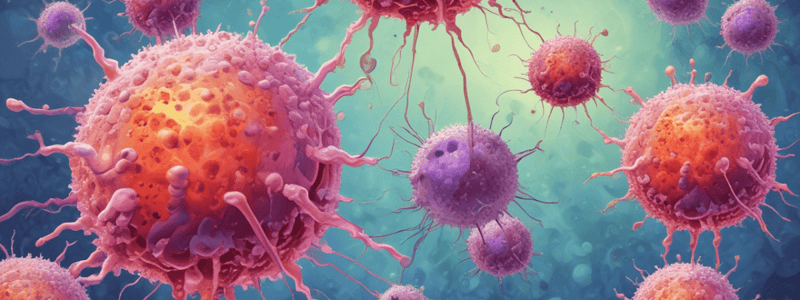Podcast
Questions and Answers
Which cells are involved in the degranulation process that releases histamines?
Which cells are involved in the degranulation process that releases histamines?
- Mast cells (correct)
- Macrophages
- Dendritic cells
- B lymphocytes
What is a major characteristic of granulomatous inflammation?
What is a major characteristic of granulomatous inflammation?
- Presence of neutrophils
- Increased fluid accumulation
- Formation of granuloma (correct)
- Rapid tissue repair
Which of the following is NOT a type of granulomatous inflammation?
Which of the following is NOT a type of granulomatous inflammation?
- Immune granuloma
- Necrotizing granuloma (correct)
- Noncaseating granuloma
- Caseating granuloma
What role do epithelioid cells play in granulomatous inflammation?
What role do epithelioid cells play in granulomatous inflammation?
Which of the following diseases is an excellent example of chronic inflammation?
Which of the following diseases is an excellent example of chronic inflammation?
What is the primary function of antigen-presenting cells?
What is the primary function of antigen-presenting cells?
Which cytokine is primarily responsible for the transformation of macrophages to epithelioid cells in granulomatous inflammation?
Which cytokine is primarily responsible for the transformation of macrophages to epithelioid cells in granulomatous inflammation?
Which of these conditions is associated with the formation of foreign body granulomas?
Which of these conditions is associated with the formation of foreign body granulomas?
What is a significant feature of immune granulomas?
What is a significant feature of immune granulomas?
Which type of granuloma typically lacks central necrosis?
Which type of granuloma typically lacks central necrosis?
What is a characteristic feature of caseating granulomas?
What is a characteristic feature of caseating granulomas?
Which cytokines are primarily involved in the acute phase reaction of inflammation?
Which cytokines are primarily involved in the acute phase reaction of inflammation?
What is the main hallmark feature of fever in the context of inflammation?
What is the main hallmark feature of fever in the context of inflammation?
What is the role of cytokines in the development of fever during inflammation?
What is the role of cytokines in the development of fever during inflammation?
Which acute phase protein is commonly elevated during inflammation and is synthesized by the liver?
Which acute phase protein is commonly elevated during inflammation and is synthesized by the liver?
What is the most common change observed in white blood cell counts during an inflammatory response?
What is the most common change observed in white blood cell counts during an inflammatory response?
What does the presence of fibrinogen in the blood indicate during inflammation?
What does the presence of fibrinogen in the blood indicate during inflammation?
Which type of cell is primarily responsible for forming giant cells in granulomas?
Which type of cell is primarily responsible for forming giant cells in granulomas?
What effect does the acute phase response have on plasma levels of acute phase proteins?
What effect does the acute phase response have on plasma levels of acute phase proteins?
What systemic effect is least common during inflammation?
What systemic effect is least common during inflammation?
Flashcards are hidden until you start studying
Study Notes
Mast Cells and Inflammation
- Mast cells are located throughout connective tissues and play a role in both acute and chronic inflammation.
- They have receptors that bind to the Fc portion of IgE, enabling them to respond to allergens.
- Degranulation of mast cells leads to the release of histamines.
Antigen Presenting Cells
- Major antigen presenting cells that present antigens to T cells include:
- Macrophages
- B lymphocytes
- Dendritic cells
Chronic Inflammation
- Chronic inflammation is critical in various diseases such as:
- Atherosclerosis
- Tuberculosis
- Rheumatoid Arthritis
- Chronic gastritis
Granulomatous Inflammation
- Defined as a unique pattern of chronic inflammation featuring granulomas.
- Granulomas consist of epithelioid histiocytes (modified macrophages) and are surrounded by giant cells and lymphocytes.
- Granulomas 'wall off' offending agents, serving as a defense mechanism.
Characteristics of Granulomas
- Epithelioid cells, resembling epithelial cells, can fuse to form multinucleated giant cells.
- Central necrosis may occur in some granulomas.
Types of Granulomatous Inflammation
- Foreign body granulomas: Reaction to inert foreign materials.
- Immune granulomas: Result from T-cell mediated reactions to poorly degradable antigens.
- Noncaseating granulomas: Lack central necrosis, common in conditions like sarcoidosis and Crohn's disease.
- Caseating granulomas: Exhibit central necrosis, typical in tuberculosis and fungal infections.
Granuloma Composition
- Consists of modified macrophages (epithelioid cells), lymphocyte collars, giant cells, and possibly necrosis.
Systemic Effects of Inflammation
- Acute inflammation displays local signs such as:
- Heat (calor)
- Redness (rubor)
- Edema (tumor)
- Pain (dolor)
- Loss of function (functio laesa)
- Systemic effects are termed "acute phase reaction," mediated by cytokines TNF-α, IL-1, and IL-6.
Acute Phase Response Changes
- Clinical responses include:
- Fever: Elevated body temperature regulated by the hypothalamus and influenced by cytokines (IL-1, TNF-α).
- Elevated levels of acute phase proteins (e.g., CRP, fibrinogen) synthesized by the liver, significantly increasing during inflammation.
- Leukocytosis: Increased white blood cell count due to rapid release from bone marrow pools during infections.
- Leukopenia: Reduced white blood cells, seen in conditions like typhoid fever.
- Other manifestations: Increased heart rate, decreased sweating, chills, malaise, and anorexia.
Septic Shock
- Occurs in severe bacterial infections where bacterial products trigger cytokine release, leading to disseminated intravascular coagulation (DIC) and metabolic disturbances.
- Results in hypotensive shock, encapsulated as a clinical triad of septic shock.
Studying That Suits You
Use AI to generate personalized quizzes and flashcards to suit your learning preferences.



